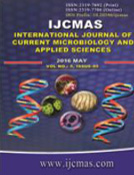


 National Academy of Agricultural Sciences (NAAS)
National Academy of Agricultural Sciences (NAAS)

|
PRINT ISSN : 2319-7692
Online ISSN : 2319-7706 Issues : 12 per year Publisher : Excellent Publishers Email : editorijcmas@gmail.com / submit@ijcmas.com Editor-in-chief: Dr.M.Prakash Index Copernicus ICV 2018: 95.39 NAAS RATING 2020: 5.38 |
Non-fermentative Gram negative bacteria can cause life threatening infections in hospitalised patients. These organisms have high intrinsic antibiotic resistance. Carbapenems are potent agents against these. Production of carbapenemases especially MBLs can jeopardise its use. Study was done to detect the prevalence of carbapenem resistance in NFGNB and to compare the different phenotypic methods for detection of MBLs. Non-duplicate isolates were collected. Isolates were identified by using phenotypic methods and following standard laboratory protocols. Imipenem resistance was detected by using CLSI guidelines. A total of 296 isolates were collected. Acinetobacter baumannii was the predominant isolate (44.59%) followed by Pseudomonas aeruginosa.71.21% of A.baumannii and 52.06% of P.aeruginosa were imipenem resistant. 86.17% of A.baumannii and 82.53% of P.aeruginosa were modified Hodge test positive.67.02% of A.baumannii and 66.66% of P.aeruginosa were Double disk synergy test positive.76.59% of A.baumannii and 77.77% of P.aeruginosa were positive for combined disk test. 74.46% of A.baumannii and 76.19% of P.aeruginosa were positive for MBL by E-test. “Almost perfect agreement” was seen between CDT and E-test for A.baumannii whereas “Substantial agreement” was seen for P.aeruginosa. Hence CDT can be used as a cheaper method for phenotypic detection of MBLs.
 |
 |
 |
 |
 |